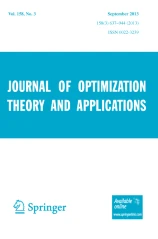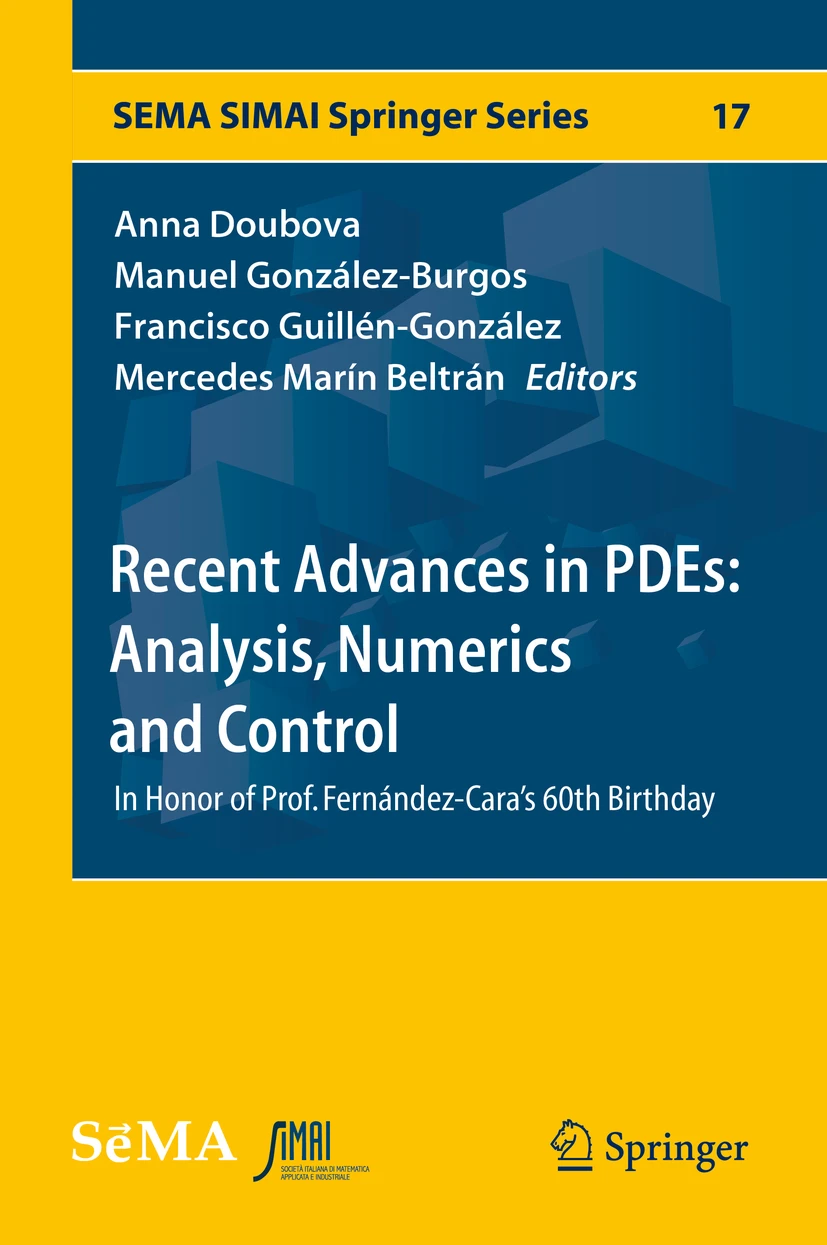Martínez-Frutos, Jesús; Allaire, Grégoire; Dapogny, Charles; Periago, Francisco Structural optimization under internal porosity constraints using topological derivatives Journal Article In: Computer Methods in Applied Mechanics and Engineering, vol. 345, pp. 1-25, 2019. Abstract | BibTeX | Tags: 19274/PI/14 | Links: Marín, Francisco J.; Martínez-Frutos, Jesús; Periago, Francisco A polynomial chaos-based approach to risk-averse piezoelectric control of random vibrations of beams Journal Article In: International Journal for Numerical Methods in Engineering, vol. 115, no. 6, pp. 738-755, 2018, ISSN: 1097-0207. Abstract | BibTeX | Tags: 19274/PI/14 | Links: Martínez-Frutos, Jesús Evolutionary topology optimization of continuum structures under uncertainty using sensitivity analysis and smooth boundary representation Journal Article In: Computers and Structures, vol. 205, pp. 15-27, 2018. Abstract | BibTeX | Tags: 19274/PI/14 | Links: Martínez-Frutos, Jesús; Kessler, Mathieu; Periago, Francisco Risk-averse structural topology optimization under random fields using stochastic expansion methods Journal Article In: Computer Methods in Applied Mechanics and Engineering, vol. 330, pp. 180-206, 2018, ISSN: 0045-7825. Abstract | BibTeX | Tags: 19274/PI/14 | Links: Marín, Francisco J.; Martínez-Frutos, Jesús; Periago, Francisco Robust Averaged Control of Vibrations for the Bernoulli-Euler Beam Equation Journal Article In: Journal of Optimization Theory and Applications, vol. 174, no. 2, pp. 428–454, 2017, ISSN: 1573-2878. Abstract | BibTeX | Tags: 19274/PI/14 | Links: Marín, Francisco J. Robust Averaged Control of Vibrations for the Bernoulli-Euler Beam Equation Conference Congress on Numerical Methods in Engineering, International Center for Numerical Methods in Engineering (CIMNE), Barcelona, Spain, 2017, ISBN: 978-84-947311-0-5. Abstract | BibTeX | Tags: 19274/PI/14 | Links: Martínez-Frutos, Jesús; Periago, Francisco Risk-averse topology optimization under random fields using stochastic expansion methods Conference Congress on Numerical Methods in Engineering, International Center for Numerical Methods in Engineering (CIMNE), Barcelona, Spain, 2017, ISBN: 978-84-947311-0-5. Abstract | BibTeX | Tags: 19274/PI/14 | Links: Lauriola, Domenico; Kessler, Mathieu; Martínez-Frutos, Jesús Efficient large-scale evolutionary topology optimization for architecture and urban design Conference Congress on Numerical Methods in Engineering, International Center for Numerical Methods in Engineering (CIMNE), Barcelona, Spain, 2017, ISBN: 978-84-947311-0-5. Abstract | BibTeX | Tags: 19274/PI/14 | Links: Martínez-Frutos, Jesús Massively Parallel Evolutionary Structural Optimization for High Resolution Architecture Design Book Chapter In: Iványi, P.; Topping, B. H. V.; Várady, G. (Ed.): Advances in Parallel, Distributed, Grid and Cloud Computing for Engineering, Chapter 3, pp. 29-49, Saxe-Coburg Publications, Stirlingshire, Scotland, 2017, ISSN: 1759-3158, (Invited Lecture at the fifth International conference on parallel, distributed, grid and cloud computing (PARENG), 2017). Abstract | BibTeX | Tags: 19274/PI/14 | Links: Martínez-Frutos, Jesús Massively Parallel Evolutionary Structural Optimization for High Resolution Architecture Design Presentation Pécs, Hungary, 30.05.2017, (V Int. Conf. Parallel, Distributed, Grid and Cloud Computing for Engineering). BibTeX | Tags: 19274/PI/14 Martínez-Frutos, Jesús Efficient topology optimization using GPU computing with multilevel granularity Journal Article In: Advances in Engineering Software, vol. 106, no. Supplement C, pp. 47 - 62, 2017, ISSN: 0965-9978. Abstract | BibTeX | Tags: 19274/PI/14 | Links: Martínez-Frutos, Jesús GPU acceleration for evolutionary topology optimization of continuum structures using isosurfaces Journal Article In: Computers & Structures, vol. 182, no. Supplement C, pp. 119 - 136, 2017, ISSN: 0045-7949. Abstract | BibTeX | Tags: 19274/PI/14 | Links: Periago, Francisco Control of random PDEs: an overview Presentation Sevilla, Spain, 01.01.2017. BibTeX | Tags: 19274/PI/14 | Links: Martínez-Frutos, Jesús Large-scale robust topology optimization using multi-GPU systems Journal Article In: Computer Methods in Applied Mechanics and Engineering, vol. 311, no. Supplement C, pp. 393 - 414, 2016, ISSN: 0045-7825, (Listed among CMAME’s most downloaded articles from December 2016- February 2017). Abstract | BibTeX | Tags: 19274/PI/14 | Links: Martínez-Frutos, Jesús; Kessler, Mathieu; Münch, Arnaud; Periago, Francisco Robust optimal Robin boundary control for the transient heat equation with random input data Journal Article In: International Journal for Numerical Methods in Engineering, vol. 108, no. 2, pp. 116–135, 2016, ISSN: 1097-0207. Abstract | BibTeX | Tags: 19274/PI/14 | Links: Martínez-Frutos, Jesús; Kessler, Mathieu; Periago, Francisco Robust shape optimization of continuous structures via the level set method Journal Article In: Computer Methods in Applied Mechanics and Engineering, vol. 305, no. Supplement C, pp. 271 - 291, 2016, ISSN: 0045-7825. Abstract | BibTeX | Tags: 19274/PI/14 | Links: Martínez-Frutos, Jesús Kriging-based infill sampling criterion for constraint handling in multi-objective optimization Journal Article In: Journal of Global Optimization, vol. 64, no. 1, pp. 97–115, 2016, ISSN: 1573-2916. Abstract | BibTeX | Tags: 19274/PI/14 | Links: Martínez-Frutos, Jesús; Kessler, Mathieu; Periago, Francisco Robust optimal shape design for an elliptic PDE with uncertainty in its input data Journal Article In: ESAIM: COCV, vol. 21, no. 4, pp. 901–923, 2015, ISSN: 1262-3377. BibTeX | Tags: 19274/PI/14, Computational Mathematics, Control and Optimization, Control and Systems Engineering | Links: 2019
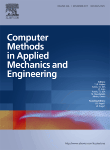
@article{Martínez-Frutos2018b,
title = {Structural optimization under internal porosity constraints using topological derivatives},
author = {Jesús Martínez-Frutos and Grégoire Allaire and Charles Dapogny and Francisco Periago},
url = {https://hal.archives-ouvertes.fr/hal-01790472v1
https://www.sciencedirect.com/science/article/pii/S0045782518305401},
doi = {https://doi.org/10.1016/j.cma.2018.10.036},
year = {2019},
date = {2019-01-01},
urldate = {2019-01-01},
journal = {Computer Methods in Applied Mechanics and Engineering},
volume = {345},
pages = {1-25},
abstract = {Porosity is a well-known phenomenon occurring during various manufacturing processes (casting, welding, additive manufacturing) of solid structures, which undermines their reliability and mechanical performance. The main purpose of this article is to introduce a new constraint functional of the domain which controls the negative impact of porosity on elastic structures in the framework of shape and topology optimization. The main ingredient of our modeling is the notion of topological derivative, which is used in a slightly unusual way: instead of being an indicator of where to nucleate holes in the course of the optimization process, it is a component of a new constraint functional which assesses the influence of pores on the mechanical performance of structures. The shape derivative of this constraint is calculated and incorporated into a level set based shape optimization algorithm. Our approach is illustrated by several two- and three-dimensional numerical experiments of topology optimization problems constrained by a control on the porosity effect.},
keywords = {19274/PI/14},
pubstate = {published},
tppubtype = {article}
}
2018

@article{Marín2018b,
title = {A polynomial chaos-based approach to risk-averse piezoelectric control of random vibrations of beams},
author = {Francisco J. Marín and Jesús Martínez-Frutos and Francisco Periago},
url = {https://onlinelibrary.wiley.com/doi/abs/10.1002/nme.5823},
issn = {1097-0207},
year = {2018},
date = {2018-08-10},
urldate = {2018-08-10},
journal = {International Journal for Numerical Methods in Engineering},
volume = {115},
number = {6},
pages = {738-755},
abstract = {This paper proposes a risk-averse formulation for the problem of piezoelectric control of random vibrations of elastic structures. The proposed formulation, inspired by the notion of risk aversion in Economy, is applied to the piezoelectric control of a Bernoulli-Euler beam subjected to uncertainties in its input data. To address the high computational burden associated to the presence of random fields in the model and the discontinuities involved in the cost functional and its gradient, a combination of a non-intrusive anisotropic polynomial chaos approach for uncertainty propagation with a Monte Carlo sampling method is proposed. In a first part, the well-posedness of the control problem is established by proving the existence of optimal controls. In a second part, an adaptive gradient-based method is proposed for the numerical resolution of the problem. Several experiments illustrate the performance of the proposed approach and the significant differences that may occur between the classical deterministic formulation of the problem and its stochastic risk-averse counterpart.},
keywords = {19274/PI/14},
pubstate = {published},
tppubtype = {article}
}

@article{Martínez-Frutos2018,
title = {Evolutionary topology optimization of continuum structures under uncertainty using sensitivity analysis and smooth boundary representation},
author = {Jesús Martínez-Frutos},
url = {https://www.sciencedirect.com/science/article/pii/S0045794917317832},
year = {2018},
date = {2018-08-01},
urldate = {2018-08-01},
journal = {Computers and Structures},
volume = {205},
pages = {15-27},
abstract = {This paper presents an evolutionary approach for the Robust Topology Optimization (RTO) of continuum structures under loading and material uncertainties. The method is based on an optimality criterion obtained from the stochastic linear elasticity problem in its weak form. The smooth structural topology is determined implicitly by an iso-value of the optimality criterion field. This isovalue is updated using an iterative approach to reach the solution of the RTO problem. The proposal permits to model the uncertainty using random variables with different probability distributions as well as random fields. The computational burden, due to the high dimension of the random field approximation, is efficiently addressed using anisotropic sparse grid stochastic collocation methods. The numerical results show the ability of the proposal to provide smooth and clearly defined structural boundaries. Such results also show that the method provides structural designs satisfying a trade-o between conflicting objectives in the RTO problem.},
keywords = {19274/PI/14},
pubstate = {published},
tppubtype = {article}
}

@article{JMF_CMAME_2017,
title = {Risk-averse structural topology optimization under random fields using stochastic expansion methods},
author = {Jesús Martínez-Frutos and Mathieu Kessler and Francisco Periago},
url = {https://www.sciencedirect.com/science/article/pii/S0045782517306990
http://www.upct.es/mc3/files/JMF/riskaverse_cmame.pdf},
issn = {0045-7825},
year = {2018},
date = {2018-03-01},
urldate = {2018-03-01},
journal = {Computer Methods in Applied Mechanics and Engineering},
volume = {330},
pages = {180-206},
abstract = {This work proposes a level-set based approach for solving risk-averse structural topology optimization problems considering random field loading and material uncertainty. The use of random fields increases the dimensionality of the stochastic domain, which poses several computational challenges related to the minimization of the Excess Probability as a measure of risk awareness. This problem is addressed both from the theoretical and numerical viewpoints. First, an existence result under a typical geometrical constraint on the set of admissible shapes is proved. Second, a level-set continuous approach to find the numerical solution of the problem is proposed. Since the considered cost functional has a discontinuous integrand, the numerical approximation of the functional and its sensitivity combine an adaptive anisotropic Polynomial Chaos (PC) approach with a Monte-Carlo (MC) sampling method for uncertainty propagation. Furthermore, to address the increment of dimensionality induced by the random field, an anisotropic sparse grid stochastic collocation method is used for the efficient computation of the PC coefficients. A key point is that the non-intrusive nature of such an approach facilitates the use of High Performance Computing (HPC) to alleviate the computational burden of the problem. Several numerical experiments including random field loading and material uncertainty are presented to show the feasibility of the proposal.},
keywords = {19274/PI/14},
pubstate = {published},
tppubtype = {article}
}
2017
@article{Marín2017,
title = {Robust Averaged Control of Vibrations for the Bernoulli-Euler Beam Equation},
author = {Francisco J. Marín and Jesús Martínez-Frutos and Francisco Periago},
url = {https://doi.org/10.1007/s10957-017-1128-x
http://localhost/mc3/files/FPE/marin_17.pdf},
doi = {10.1007/s10957-017-1128-x},
issn = {1573-2878},
year = {2017},
date = {2017-08-01},
urldate = {2017-08-01},
journal = {Journal of Optimization Theory and Applications},
volume = {174},
number = {2},
pages = {428–454},
abstract = {This paper proposes an approach for the robust averaged control of random vibrations for the Bernoulli–Euler beam equation under uncertainty in the flexural stiffness and in the initial conditions. The problem is formulated in the framework of optimal control theory and provides a functional setting, which is so general as to include different types of random variables and second-order random fields as sources of uncertainty. The second-order statistical moment of the random system response at the control time is incorporated in the cost functional as a measure of robustness. The numerical resolution method combines a classical descent method with an adaptive anisotropic stochastic collocation method for the numerical approximation of the statistics of interest. The direct and adjoint stochastic systems are uncoupled, which permits to exploit parallel computing architectures to solve the set of deterministic problem that arise from the stochastic collocation method. As a result, problems with a relative large number of random variables can be solved with a reasonable computational cost. Two numerical experiments illustrate both the performance of the proposed method and the significant differences that may occur when uncertainty is incorporated in this type of control problems.},
keywords = {19274/PI/14},
pubstate = {published},
tppubtype = {article}
}

@conference{Marín2017b,
title = {Robust Averaged Control of Vibrations for the Bernoulli-Euler Beam Equation},
author = {Francisco J. Marín},
editor = {Irene Arias and Jesús María Blanco and Stephane Clain and Paulo Flores and Paulo Lourenço and Juan José Ródenas and Manuel Tur},
url = {http://www.upct.es/mc3/files/FJM/FJMARIN_CMNE2017.pdf},
isbn = {978-84-947311-0-5},
year = {2017},
date = {2017-07-03},
urldate = {2017-07-03},
booktitle = {Congress on Numerical Methods in Engineering},
pages = {1539},
publisher = {International Center for Numerical Methods in Engineering (CIMNE)},
address = {Barcelona, Spain},
abstract = {This paper proposes an approach for the robust averaged control of random vibrations for the Bernoulli-Euler beam equation under uncertainty inthe flexural stiffness and in the initial conditions. The problem is formulated in the framework of optimal control theory and provides a functional setting which is so general as to include different types of random variables and second order random fields as sources of uncertainty. The second order statistical moment of the random system response at the control time is incorporated in the cost functional as a measure of robustness. The numerical resolution method combines a classical descent method with an adaptive anisotropic stochastic collocation method for the numerical approximation of the statistics of interest. Since the stochastic direct and adjoint systems are uncoupled,the set of decoupled deterministic problems that arises from the stochastic collocation method are solved in parallel which reduces the computational burden and permits to solve problems with a relative large number of terms in the truncated Karhunen-Loève expansion of a random field. Two numerical experiments illustrate both the performance of the proposed method and the significant differences that may occur when uncertainty is incorporated in this type of control problems.},
keywords = {19274/PI/14},
pubstate = {published},
tppubtype = {conference}
}

@conference{Martínez-Frutos2017bc,
title = {Risk-averse topology optimization under random fields using stochastic expansion methods},
author = {Jesús Martínez-Frutos and Francisco Periago},
editor = {Irene Arias and Jesús María Blanco and Stephane Clain and Paulo Flores and Paulo Lourenço and Juan José Ródenas and Manuel Tur},
url = {http://www.upct.es/mc3/files/JMF/Abstract_CMN2017_risk.pdf},
isbn = {978-84-947311-0-5},
year = {2017},
date = {2017-07-03},
urldate = {2017-07-03},
booktitle = {Congress on Numerical Methods in Engineering},
pages = {1538},
publisher = {International Center for Numerical Methods in Engineering (CIMNE)},
address = {Barcelona, Spain},
abstract = {Although significant numerical and theoretical developments have been achieved in Topology Optimization Under Uncertainty (TOUU), several computational challenges still remain. One
of them stems from the fact that when the solution of the underlying PDE is expensive, one can only afford to solve a few hundred samples, which is far from the required number for
estimating a probability of failure. This drawback is exacerbated in high-dimensional spaces. This study is concerned with the accurate and efficient solution of TOUU problems involving
probabilities of failure in their formulation. For this purpose, an approach based on the use of anisotropic stochastic expansion methods is proposed. This approach is especially well suited
for risk-averse and reliability-based topology optimization, which involve the computation of probabilities of failure in the functional cost and/or in the constraints. The evaluation of probabilities
of failure of the cost functional requires integrations over failure regions. Due to the non-differentiable character of the cost functional, this work proposes a numerical approximation
of this functional and its sensitivities by combining a non-intrusive polynomial chaos approach for uncertainty propagation with a Monte-Carlo sampling method. This approach
permits an accurate and efficient estimation of quantities of interest such as statistical moments and failure probabilities. Furthermore, the proposal provides a unified framework to address
some of the different formulations that incorporate, in a wide sense, the concept of “structural robustness”, namely, robust design [1], reliability-based and risk-averse topology optimization.
Some numerical experiments including loading and material uncertainty and random fields are presented to illustrate the proposal.},
keywords = {19274/PI/14},
pubstate = {published},
tppubtype = {conference}
}
of them stems from the fact that when the solution of the underlying PDE is expensive, one can only afford to solve a few hundred samples, which is far from the required number for
estimating a probability of failure. This drawback is exacerbated in high-dimensional spaces. This study is concerned with the accurate and efficient solution of TOUU problems involving
probabilities of failure in their formulation. For this purpose, an approach based on the use of anisotropic stochastic expansion methods is proposed. This approach is especially well suited
for risk-averse and reliability-based topology optimization, which involve the computation of probabilities of failure in the functional cost and/or in the constraints. The evaluation of probabilities
of failure of the cost functional requires integrations over failure regions. Due to the non-differentiable character of the cost functional, this work proposes a numerical approximation
of this functional and its sensitivities by combining a non-intrusive polynomial chaos approach for uncertainty propagation with a Monte-Carlo sampling method. This approach
permits an accurate and efficient estimation of quantities of interest such as statistical moments and failure probabilities. Furthermore, the proposal provides a unified framework to address
some of the different formulations that incorporate, in a wide sense, the concept of “structural robustness”, namely, robust design [1], reliability-based and risk-averse topology optimization.
Some numerical experiments including loading and material uncertainty and random fields are presented to illustrate the proposal.
@conference{Lauriola2017,
title = {Efficient large-scale evolutionary topology optimization for architecture and urban design},
author = {Domenico Lauriola and Mathieu Kessler and Jesús Martínez-Frutos},
editor = {Irene Arias and Jesús María Blanco and Stephane Clain and Paulo Flores and Paulo Lourenço and Juan José Ródenas and Manuel Tur},
url = {poster http://www.upct.es/mc3/files/JMF/poster_JMF.pdf
http://www.upct.es/mc3/files/JMF/Abstract_CMN2017.pdf},
isbn = {978-84-947311-0-5},
year = {2017},
date = {2017-07-03},
urldate = {2017-07-03},
booktitle = {Congress on Numerical Methods in Engineering},
pages = {544},
publisher = {International Center for Numerical Methods in Engineering (CIMNE)},
address = {Barcelona, Spain},
abstract = {This paper shows how the proper use of massively parallel architectures can increase significantly the tractable resolution of topology optimization problems in the field of architecture and urban design. Evolutionary topology optimization techniques are redefining architectural practice providing structurally sound and aesthetically pleasing architectural designs, which commonly mimic nature’s own evolutionary optimization process. Though these techniques provide architects with a powerful tool to integrate function and form in a synergistic way, their computational cost in terms of memory consumption and processing time still remain as a cutting edge challenge. This work aims to alleviate these constraints proposing a well-suited strategy for Graphics Processing Unit (GPU) computing. Such a proposal makes use of fine-grained assembly-free methods along with multilevel parallelizable preconditioner, which increase significantly the tractable resolution of the models. The stages of the evolutionary topology optimization pipeline using GPU are compared to the classically used CPU implementation achieving significant speedups. The proposal is evaluated in high resolution real-world architecture and urban designs.},
keywords = {19274/PI/14},
pubstate = {published},
tppubtype = {conference}
}
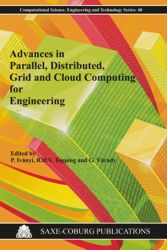
@inbook{Martínez-Frutos2017,
title = {Massively Parallel Evolutionary Structural Optimization for High Resolution Architecture Design},
author = {Jesús Martínez-Frutos},
editor = {P. Iványi and B. H. V. Topping and G. Várady},
url = {http://www.ctresources.info/csets/chapter.html?id=645},
doi = {10.4203/csets.40.3},
issn = {1759-3158},
year = {2017},
date = {2017-07-01},
urldate = {2017-07-01},
booktitle = {Advances in Parallel, Distributed, Grid and Cloud Computing for Engineering},
pages = {29-49},
publisher = {Saxe-Coburg Publications},
address = {Stirlingshire, Scotland},
chapter = {3},
series = {Computational Science, Engineering & Technology Series},
abstract = {This paper shows how the proper use of massively parallel architectures can increase significantly the tractable resolution of topology optimization problems in the field of architecture and urban design. Evolutionary topology optimization techniques are redefining architectural practice providing structurally sound and aesthetically pleasing architectural designs, which commonly mimic nature’s own evolutionary optimization process. Though these techniques provide architects with a powerful tool to integrate function and form in a synergistic way, the resolution of the models to obtain proper designs may be challenging both in computation and memory consumption terms. This work aims to alleviate these constraints proposing a well-suited strategy for Graphics Processing Unit (GPU) computing. Such a proposal makes use of fine grained assembly-free methods along with multilevel parallelizable preconditioner, which notably increase the tractable resolution of the models. The stages of the evolutionary topology optimization pipeline using GPU are compared to the classically used CPU implementation achieving significant speedups. The proposal is evaluated in high resolution real-world architecture and urban designs.},
note = {Invited Lecture at the fifth International conference on parallel, distributed, grid and cloud computing (PARENG), 2017},
keywords = {19274/PI/14},
pubstate = {published},
tppubtype = {inbook}
}

@misc{Martínez-Frutos2017b,
title = {Massively Parallel Evolutionary Structural Optimization for High Resolution Architecture Design},
author = {Jesús Martínez-Frutos},
year = {2017},
date = {2017-05-30},
urldate = {2017-05-30},
address = {Pécs, Hungary},
note = {V Int. Conf. Parallel, Distributed, Grid and Cloud Computing for Engineering},
keywords = {19274/PI/14},
pubstate = {published},
tppubtype = {presentation}
}

@article{MARTINEZFRUTOS201747,
title = {Efficient topology optimization using GPU computing with multilevel granularity},
author = {Jesús Martínez-Frutos},
url = {http://www.sciencedirect.com/science/article/pii/S0965997816302332},
doi = {https://doi.org/10.1016/j.advengsoft.2017.01.009},
issn = {0965-9978},
year = {2017},
date = {2017-04-01},
urldate = {2017-04-01},
journal = {Advances in Engineering Software},
volume = {106},
number = {Supplement C},
pages = {47 - 62},
abstract = {Abstract This paper proposes a well-suited strategy for High Performance Computing (HPC) of density-based topology optimization using Graphics Processing Units (GPUs). Such a strategy takes advantage of Massively Parallel Processing (MPP) architectures to overcome the computationally demanding procedures of density-based topology design, both in terms of memory consumption and processing time. This is done exploiting data locality and minimizing both memory consumption and data transfers. The proposed GPU instance makes use of different granularities for the topology optimization pipeline, which are selected to properly balance the workload between the threads exploiting the parallelization potential of massively parallel architectures. The performance of the fine-grained GPU instance of the solving stage is evaluated using two preconditioning techniques. The proposal is also compared with the classical CPU implementation for diverse topology optimization problems, including stiffness maximization, heat sink design and compliant mechanism design.},
keywords = {19274/PI/14},
pubstate = {published},
tppubtype = {article}
}

@article{MARTINEZFRUTOS2017119,
title = {GPU acceleration for evolutionary topology optimization of continuum structures using isosurfaces},
author = {Jesús Martínez-Frutos},
url = {http://www.sciencedirect.com/science/article/pii/S004579491630459X},
doi = {https://doi.org/10.1016/j.compstruc.2016.10.018},
issn = {0045-7949},
year = {2017},
date = {2017-04-01},
urldate = {2017-04-01},
journal = {Computers & Structures},
volume = {182},
number = {Supplement C},
pages = {119 - 136},
abstract = {Abstract Evolutionary topology optimization of three-dimensional continuum structures is a computationally demanding task in terms of memory consumption and processing time. This work aims to alleviate these constraints proposing a well-suited strategy for Graphics Processing Unit (GPU) computing. Such a proposal adopts a fine-grained GPU instance of matrix-free iterative solver for structural analysis and an efficient GPU implementation for isosurface extraction and volume fraction calculation. The performance of the solving stage is evaluated using two preconditioning techniques, including the comparison with the sparse-matrix CPU implementation. The proposal is evaluated using topology optimization problems for real-world applications.},
keywords = {19274/PI/14},
pubstate = {published},
tppubtype = {article}
}
@misc{Periago2017,
title = {Control of random PDEs: an overview},
author = {Francisco Periago},
url = {http://localhost/mc3/files/FPE/periago_Sevilla_2017.pdf},
year = {2017},
date = {2017-01-01},
urldate = {2017-01-01},
address = {Sevilla, Spain},
keywords = {19274/PI/14},
pubstate = {published},
tppubtype = {presentation}
}
2016

@article{MARTINEZFRUTOS2016393,
title = {Large-scale robust topology optimization using multi-GPU systems},
author = {Jesús Martínez-Frutos},
url = {http://www.sciencedirect.com/science/article/pii/S0045782516309574},
doi = {https://doi.org/10.1016/j.cma.2016.08.016},
issn = {0045-7825},
year = {2016},
date = {2016-11-01},
urldate = {2016-11-01},
journal = {Computer Methods in Applied Mechanics and Engineering},
volume = {311},
number = {Supplement C},
pages = {393 - 414},
abstract = {Abstract Robust topology optimization of continuum structures is an intensive computational task due to the use of uncertainty propagation methods to estimate the statistical metrics within the topology optimization process. Such a computational problem is exacerbated for large finite element (FE) models in terms of memory consumption and processing time. For these reasons, the efficient resolution of robust topology optimization with large models remains an important computational challenge. This work aims to alleviate these computational constraints proposing a well-suited strategy for Graphics Processing Unit (GPU) computing. Such a proposal exploits the multilevel parallelism provided by multi-GPU systems for the parallel execution both within FE models and through uncertainty propagation methods. Task-level parallelism is used to concurrently evaluate the independent simulation models arising from a sparse grid stochastic collocation method. Data-level parallelism with different granularities is then exploited for the efficient resolution of each simulation model and the computation required by the topology optimization process. The resolution of the different calculations of robust topology optimization pipeline using multi-GPU systems are compared to the classically used multi-CPU implementation achieving significant speedups.},
note = {Listed among CMAME’s most downloaded articles from December 2016- February 2017},
keywords = {19274/PI/14},
pubstate = {published},
tppubtype = {article}
}

@article{NME:NME5210,
title = {Robust optimal Robin boundary control for the transient heat equation with random input data},
author = {Jesús Martínez-Frutos and Mathieu Kessler and Arnaud Münch and Francisco Periago},
url = {http://dx.doi.org/10.1002/nme.5210
http://localhost/mc3/files/FPE/ijnme_16.pdf},
doi = {10.1002/nme.5210},
issn = {1097-0207},
year = {2016},
date = {2016-03-02},
urldate = {2016-03-02},
journal = {International Journal for Numerical Methods in Engineering},
volume = {108},
number = {2},
pages = {116–135},
abstract = {The problem of robust optimal Robin boundary control for a parabolic partial differential equation with uncertain input data is considered. As a measure of robustness, the variance of the random system response is included in two different cost functionals. Uncertainties in both the underlying state equation and the control variable are quantified through random fields. The paper is mainly concerned with the numerical resolution of the problem. To this end, a gradient-based method is proposed considering different functional costs to achieve the robustness of the system. An adaptive anisotropic sparse grid stochastic collocation method is used for the numerical resolution of the associated state and adjoint state equations. The different functional costs are analysed in terms of computational efficiency and its capability to provide robust solutions. Two numerical experiments illustrate the performance of the algorithm. Copyright © 2016 John Wiley & Sons, Ltd.},
keywords = {19274/PI/14},
pubstate = {published},
tppubtype = {article}
}

@article{MARTINEZFRUTOS2016271,
title = {Robust shape optimization of continuous structures via the level set method},
author = {Jesús Martínez-Frutos and Mathieu Kessler and Francisco Periago},
url = {http://www.sciencedirect.com/science/article/pii/S0045782516300834
http://localhost/mc3/files/FPE/cmame16.pdf},
doi = {https://doi.org/10.1016/j.cma.2016.03.003},
issn = {0045-7825},
year = {2016},
date = {2016-01-15},
urldate = {2016-01-15},
journal = {Computer Methods in Applied Mechanics and Engineering},
volume = {305},
number = {Supplement C},
pages = {271 - 291},
abstract = {Abstract This work proposes a stochastic shape optimization method for continuous structures using the level-set method. Such a method aims to minimize the expected compliance and its variance as measures of the structural robustness. The behavior of continuous structures is modeled by linear elasticity equations with uncertain loading and material. This uncertainty can be modeled using random variables with different probability distributions as well as random fields. The proper problem formulation is ensured by the proof of the existence colorrev of solution under certain geometrical constraints on the set of admissible shapes. The proposed method addresses the stochastic linear elasticity problem in its weak form obtaining the explicit expressions for the continuous shape derivatives. Some numerical examples are presented to show the effectiveness of the proposed approach.},
keywords = {19274/PI/14},
pubstate = {published},
tppubtype = {article}
}
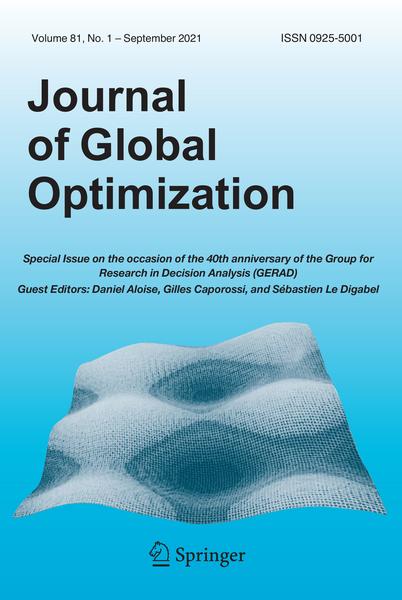
@article{Martínez-Frutos2016,
title = {Kriging-based infill sampling criterion for constraint handling in multi-objective optimization},
author = {Jesús Martínez-Frutos},
url = {https://doi.org/10.1007/s10898-015-0370-8},
doi = {10.1007/s10898-015-0370-8},
issn = {1573-2916},
year = {2016},
date = {2016-01-01},
urldate = {2016-01-01},
journal = {Journal of Global Optimization},
volume = {64},
number = {1},
pages = {97–115},
abstract = {This paper proposes a novel infill sampling criterion for constraint handling in multi-objective optimization of computationally expensive black-box functions. To reduce the computational burden, Kriging models are used to emulate the objective and constraint functions. The challenge of this multi-objective optimization problem arises from the fact that the epistemic uncertainty of the Kriging models should be taken into account to find Pareto-optimal solutions in the feasible domain. This is done by the proposed sampling criterion combining the Expected HyperVolume Improvement of the front of nondominated solutions and the Probability of Feasibility of new candidates. The proposed criterion is non-intrusive and derivative-free, and it is oriented to: (1) problems in which the computational cost is mainly from the function evaluation rather than optimization, and (2) problems that use complex in-house or commercial software that cannot be modified. The results using the proposed sampling criterion are compared with the results using Multi-Objective Evolutionary Algorithms. These results show that the proposed sampling criterion permits to identify both the feasible domain and an approximation of the Pareto front using a reduced number of computationally expensive simulations.},
keywords = {19274/PI/14},
pubstate = {published},
tppubtype = {article}
}
2015

@article{Martínez-Frutos2015,
title = {Robust optimal shape design for an elliptic PDE with uncertainty in its input data},
author = {Jesús Martínez-Frutos and Mathieu Kessler and Francisco Periago},
doi = {10.1051/cocv/2014049},
issn = {1262-3377},
year = {2015},
date = {2015-05-20},
urldate = {2015-05-20},
journal = {ESAIM: COCV},
volume = {21},
number = {4},
pages = {901--923},
publisher = {EDP Sciences},
keywords = {19274/PI/14, Computational Mathematics, Control and Optimization, Control and Systems Engineering},
pubstate = {published},
tppubtype = {article}
}










